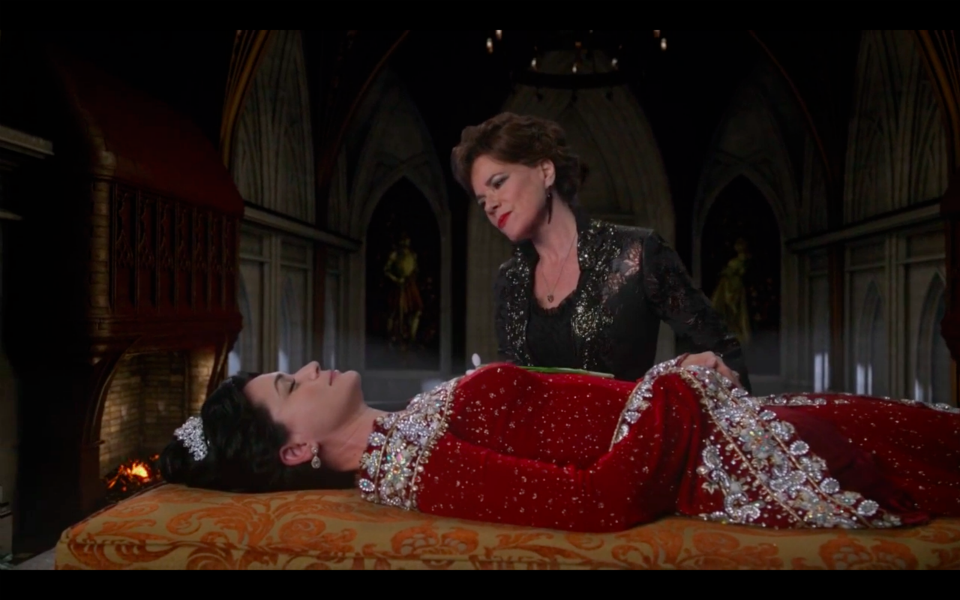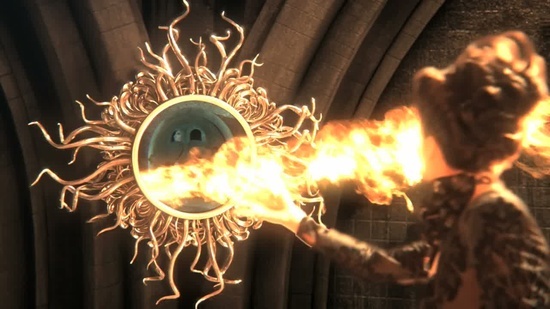|
Mix and Match by Teresa Martin--@Teresa__Martin One of the most exciting aspects of Once Upon a Time is the way that the show takes the fairy tale characters that we are familiar with and puts a modern twist on them. Hence it was rather shocking to discover the ultimate twist while researching the Grimm Brothers: the Evil Queen is actually Snow White’s mother! The original story, based on the oral version that had been passed on over the years, had the Queen who so famously wished for a daughter, actually growing jealous of her. So even though Once has the claim-to-fame of twisting fairy tales for a modern age, it was the Grimms themselves who are responsible for the ultimate switch-a-roo. When they published their work in 1812, many were reading the tales for the first time, and, finding that the stories were popular with children, they chose to tone it down in the second edition to change the evil birth- mother to the stepmother. That is how the evil stepmother was created. So why not add another twist as was presented in “The Queen is Dead” and have a Snow White who finally has decided “Enough is Enough! I have had it with these mother-censored good decisions on these mother-censored Lands,” and go Medieval on Cora? Why not indeed? The Grimms originally recorded the tale “Sneewittchen” from oral interviews given with those of lower to middle classes who recited in the Low German dialect what they recalled from childhood, or from the hours spinning and telling the tales to each other to pass the time. The narrative generally went as the brothers recorded it: Once upon a time in the middle of winter, when snowflakes the size of feathers were falling from the sky, a queen was sitting and sewing by a window with an ebony frame. While she was sewing, she looked out at the snow and pricked her dinger with a needle. Three drops of blood fell onto the snow. The red looked so beautiful against the white snow that she thought: “If only I had a child as white as snow, as red, as blood, and as black as the wood of the window frame?" (Tatar) Fairy Tale scholars Sandra Gilbert and Susan Gubar have analyzed that the queen is a woman “confined” (Tatar, 249). A person thus trapped usually seeks an escape, often in a superficial solution. In this case it was in a beautiful baby with desired features. Also notable is the tri-fold formula of the blood drops: divine, supernatural, perfect. There is something mystical and pure therefore in the wish upon which Snow’s conception occurs. The Queen’s later jealousy gives a new meaning to be careful what you wish for. “All ‘magic’ comes with a price” and the price was granting her wish. For her child became all that she wished for and hence her rival. Though has this version really been abandoned by all? One could argue that the writers of Once Upon a Time have revived this original version of the tale, but instead of Snow and her Mother, it is Regina and Cora. Cora, in her entrapment as a low-born Miller’s Daughter, pits all of her ambitions on the birth of a child who will be the regent. This ambition is rooted in vanity. Her daughter’s rise will be hers vicariously, but unlike the original Snow White, the mother succeeds in taking her daughter’s heart—for Regina’s heart was in Daniel. Hook revealed the Once canon of a person’s heart living symbolically in the one they love. Cora may not dance to her death, but her path certainly is leading to dancing on her own grave whether literally or figuratively, for the reward for envy is death. In the second edition and later popular adaptations, Snow’s White’s mother is a rather undeveloped character. She is the same queen who looks out the window who wishes for a daughter. The only difference is that she dies in childbirth and slips away. Next the stepmother arrives and she is the envious and vain one who tries to kill Snow White. Once keeps to this. Perhaps it would have been a more interesting plot in hindsight if it really was jealously of her beauty that caused the hate. But since that scenario did not occur on the show, the viewer must leave that aside and perhaps ponder that envy of a happy ending is comparable to beauty, especially when one considers that it is the happy ending that Regina envies. This aspect of the Queen’s personality is revealed when she asks her magic mirror who the fairest of them all was. When the mirror answered that the fairest was her daughter, she reaped her bitter price for vanity, which we now see was inherent in her wish for seeking her happiness from her child’s rewards. Her wish through the window did not free her, but entrapped her. She then seeks to kill her daughter and have her inner organs brought to her to eat. But it was a stag’s, for the Huntsman did not have the heart to murder a child. When Snow runs away and finds refuge with the dwarves, the mother finds her daughter and, after poisoning her with an apple, utters one of the most chilling obituaries in fairy tale lore: a repeat of the characteristics she had wished for Snow. The happy ending for Snow is well known, as is the creepy demise of the mother who when attending the wedding is danced to death with red-hot shoes. This original version of Snow White is very compelling and disturbing. The many who told the oral tales to the brothers, the Proto Evil Regals, may have expressed displeasure at the change, but without twitter, any such reaction has not been recorded for posterity. There are more similarities to the Once version presented in “The Queen Is Dead.” Snow White in the tale is indirectly responsible for her mother’s death, as is Snow for refusing to use dark magic and both are connected in that they “killed” their mothers on their birthdays. Eva, the name of Snow’s mother in Once, does wish something for her daughter, but it is not white skin, but rather that she will be strong like the flowers that withstand the winter and, despite the hardship, still thrive and bloom. In the flashback scene, the viewer observes that Eva is a saintly character when she chides her daughter for pride in their royal status. Eva is the purer version of the Queen that the Grimms originally recorded, who symbolically looked out the window, but not for herself. She is presented to the viewers in a magnificent red gown signifying her royalty, but also her fate. Red is traditionally the color of a martyr and in traditional Christianity used as a vestment for the celebrant. Martyrs give up their lives for a great cause. In this case, Eva gives up her life rather than allowing her daughter to turn to darkness and commit murder. Another aspect of Queen Eva is one that brings up an iconic character: Eve from the Garden of Eden. She must be revisited as she is presented so obviously with both the color of Eva’s dress, and her name. The red apple is a symbol of wisdom, but also of the forbidden. For Snow, her forbidden fruit is the temptations to murder to save her mother. Young Snow passes the test, an older, more jaded Snow may not. Snow as Queen has been presented with several difficult decisions both struggling with human law, as was analyzed in the previous essay, but also the higher, Natural Law. Both are essential for an ordered society. Yet it is very tempting to break them for the greater good. This dilemma was brilliantly presented in the Oscar winning A Man for all Seasons when the screenwriter, almalgating the different writings of Thomas More, dramatizes in the following dialogue with his son-in-law: William Roper: So, now you give the Devil the benefit of law! Sir Thomas More: Yes! What would you do? Cut a great road through the law to get after the Devil? William Roper: Yes, I'd cut down every law in England to do that! Sir Thomas More: Oh? And when the last law was down, and the Devil turned 'round on you, where would you hide, Roper, the laws all being flat? This country is planted thick with laws, from coast to coast, Man's laws, not God's! And if you cut them down, and you're just the man to do it, do you really think you could stand upright in the winds that would blow then? Such is the question that “The Queen is Dead” ingeniously presented. Charming tries to remind Snow that “man’s laws” will work by bringing Regina and Cora to justice. Implicit in this is his appeal to the higher, Natural Law, which can be illustrated also with a further line from A Man for All Seasons: Sir Thomas More: Some men think the Earth is round, others think it flat; it is a matter capable of question. But if it is flat, will the King's command make it round? And if it is round, will the King's command flatten it? This is Queen Snow’s limitation. Nothing she chooses to do can justify her intentions or actions. Murder is universally recognized as the “forbidden act” in all fairy tales that represents a line that can, but must not be crossed. Storybrooke literally has that line which, once crossed, the consequences are so momentous that people literally forget who they are. They lose their souls. Previously, Snow had made consistent decisions based on an informed and mature conscience. By ignoring this, Snow has forgotten who she is, and has made the title true: “The Queen is Dead.” And it won’t matter that she changed her mind in the end. Works Cited
Tatar, Maria Ed. "Snow White." Jacob and Wilhelm Grimm. The Annotated Brothers Grimm. New York: W. W. Norton & Company, 2012. 246-261. Print. Special thanks to @OnceGermany and @Waldseepiratin for helping me with the German texts and explaining the dialects, Peter Pizzola for commenting that there may be more than one Queen dying in “the Queen is Dead,” and a heartfelt apology to the Medieval Era and the movie Snakes on a Plane.
0 Comments
Leave a Reply. |
OriginsExplore the Arthurian legend surrounding Lancelot, take a trip into the woods to discover the mythology behind Red Riding Hood or learn more about a modern day hero called Snow White. Origins provides unique insights and perspectives from talented writers into the characters we know and love, going far beyond the boundaries of Storybrooke. Archives
August 2016
Categories
All
|




